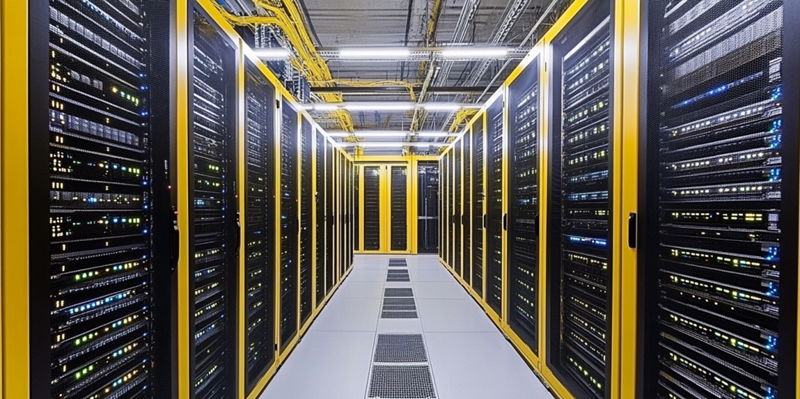The field of data center networking technologies is rapidly evolving, driven by the increasing need for enhanced computing power, faster processing speeds, and expansive storage capacities. This demand stems from the ever-growing reliance on data centers to deliver critical services swiftly and securely to end users. A data center network integrates various networking resources such as switches, routers, and other hardware components that collectively provide the connectivity and security necessary for running applications and processing data. According to Juniper Networks, these components are essential for maintaining the flow and protection of data within the data center ecosystem. The global market for data center networking was valued at $21.43 billion in 2022, with North America leading the market due to the rising application of 5G technology.
Software-Defined Networking (SDN)
Software-Defined Networking (SDN) is a cornerstone of a Software-Defined Data Center (SDDC). It abstracts physical network resources from the logical network topology, allowing for real-time bandwidth adjustments and reassignments. This abstraction facilitates optimized management of compute, storage, and networking resources without necessitating physical infrastructure modifications, thus enhancing network agility and performance.
SDN’s ability to dynamically adjust network configurations in response to changing demands makes it a critical technology for modern data centers. By decoupling the control plane from the data plane, SDN enables centralized network management, which simplifies the deployment of new services and improves overall network efficiency. This centralized approach also enhances security by allowing for more consistent policy enforcement across the network.
The flexibility provided by SDN is particularly beneficial in environments where rapid scaling is required, such as during peak usage times or when deploying new applications. This technology’s ability to quickly adapt to changing conditions helps ensure that data centers can meet the demands of their users without compromising performance or security. Moreover, SDN supports the rapid deployment of new services, which is essential in a competitive landscape where speed and reliability are paramount.
Network Overlays
Network overlays create virtual networks on top of physical networks to deploy flexible services. This technology enables dynamic scaling, segmentation, and secure connectivity, making it an essential component of modern data centers. Overlay networks provide a fully meshed fabric of VXLAN tunnels, significantly improving network agility and functionality across multiple data centers.
The use of network overlays allows data centers to create isolated virtual networks that can be tailored to specific applications or tenants. This segmentation enhances security by limiting the potential impact of a breach to a single virtual network, rather than the entire physical network. Additionally, network overlays facilitate the deployment of multi-tenant environments, where different customers or applications can share the same physical infrastructure without interfering with each other.
By abstracting the underlying physical network, overlays also simplify the process of network management and troubleshooting. Network administrators can focus on the logical topology and make changes without worrying about the physical layout, which can be particularly complex in large data centers. This abstraction layer helps streamline operations and reduce the risk of configuration errors. Furthermore, the ability to dynamically scale and segment network resources ensures that data centers can efficiently handle varying workloads and maintain high levels of service reliability.
Network Function Virtualization (NFV)
Network Function Virtualization (NFV) utilizes cloud and virtualization technologies to host communications and networking services on standardized server hardware. This approach allows network functions to be controlled and manipulated by software, fostering the development of new network services and enhancing resource utilization.
NFV’s ability to virtualize network functions such as firewalls, load balancers, and intrusion detection systems enables data centers to deploy these services more quickly and cost-effectively. By running these functions on commodity hardware, data centers can reduce their reliance on specialized, and often expensive, networking equipment. This shift to software-based network functions also allows for greater flexibility in scaling and updating services.
The adoption of NFV is driving innovation in the development of new network services. Because network functions are no longer tied to specific hardware, developers can create and deploy new services more rapidly. This agility is crucial in today’s fast-paced digital landscape, where the ability to quickly respond to changing demands can provide a significant competitive advantage. Additionally, NFV facilitates the efficient management of network resources, leading to cost savings and improved service delivery in data center operations.
Network Automation
Network automation automates the configuration, management, testing, deployment, and operation of network devices without human intervention. AI-driven systems support this automation by configuring settings based on real-time traffic and updating configurations to comply with security policies, thereby increasing efficiency and reducing manual tasks.
The implementation of network automation tools helps data centers manage their increasingly complex environments more effectively. By automating routine tasks, network administrators can focus on more strategic activities, such as optimizing network performance and planning for future growth. Automation also helps reduce the risk of human error, which can lead to network outages or security vulnerabilities.
AI-driven network automation systems can analyze real-time traffic patterns and make adjustments to optimize performance and ensure compliance with security policies. These systems can also proactively identify potential issues and take corrective action before they impact users. This proactive approach helps maintain high levels of network reliability and performance. Moreover, network automation supports the scalability of data centers, enabling them to handle large volumes of data and user requests with minimal manual intervention.
Edge Computing
Edge computing distributes data processing closer to the source of data production to reduce latency and bandwidth use. This approach can alleviate the data load on centralized data centers, enhance real-time processing, and improve overall network efficiency. It enables faster data analysis and decision-making, especially critical in applications such as IoT, autonomous vehicles, and real-time analytics. By offloading data processing to the edge, data centers can focus on large-scale data storage and management tasks, contributing to a more balanced and efficient data processing system. This ensures that data is processed quickly and efficiently, enhancing the performance and reliability of data center networks.

